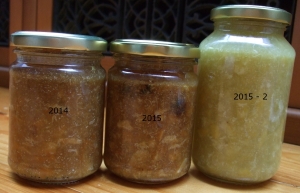Our lime tree has been a little too bountiful this year. I will be pruning harshly when it has finished fruiting. There is some overlap between how I harvest and how I prune at the moment. I am very fond of limes, but there is a limit to how many we can consume and give to others. Some people remind me of one of my cousins, who when given a pumpkin asked: ‘What am I supposed to do with this?’ We felt embarassed on her behalf. I admit that limes do not play the same role as pumpkins do in meals, so I do not expect people to be rushing to accept limes from us.
Anyway, with the abundance I felt obliged to make some lime marmalade. I tried last year, and made four or five jars of a marmalade that did not set, so perhaps I should call it lime syrup. I like having it on yoghurt, and I found its astringency excellent for frightening away hiccups, a very effective treatment.
So this year I tried making some more marmalade, two batches, and filled more jars per batch.
The first batch set, the second didn’t. The first had a few lemons in it, the second had limes alone (although I did add lemon pips and juice at the appropriate time). The first may have had burnt bits, the second is refreshingly pale. Both contain the fruit pulp, which bothered me, as commercial marmalades are so clear and jelly-like, and when I listened to a BBC Food Programme podcast about marmalade, I could not believe that my attempts would be considered acceptable.
I followed the method described in the Paddington Cookery Book, a method that involves boiling the fruit until the skin is soft, then using the same water to boil the chopped cooled peel and the juice, with a few lemon pips for the pectin. I think I boiled the whole fruit for too long, so that the interior disintegrated, making pulp and juice inseparable (maybe that could be overcome with a sieve, but ours is used to sift flour, and has been a problematic source of gluten contamination, and I keep forgetting to buy one to reserve for non-gluten use). I also skimped on the sugar, as I don’t like overly sweet foods, and I know that I am going to be the only one consuming the marmalade. This probably contributed to the lack of setting, along with being impatient to ladle the marmalade into jars. I’m even impatient when testing it for setting on the cool plate. Next time I might try crushing the lemon pips, as advised by one of the participants on the Food Programme. Or I might decide that I am making a syrup and not a marmalade, and not worry about it.
Last week I had a terrible headache, and while lying on the couch nibbling on popcorn and gulping down coffee, I decided to consult Mrs Beeton on marmalade. I was very pleased to discover that all of the methods she described included adding the pulp to the mixture (tossing it seems wasteful to me, and perhaps it did to her, too). Of course, I could not resist flicking through the rest of the book, and in my self-pitying state it seemed dreadful that I could not be an invalid with someone tempting my appetite with dainty little morsels on a tray, and that instead I had to do it all myself. I changed my mind when I read further and felt sorry for the invalids, given what was placed on those trays. However, in all that flicking, I was rewarded by the following, regarding the feeding of infants in bed during the night: “…she wakes languid and unrefreshed from her sleep, with febrile symptoms and hectic flushes, caused by her baby vampire, who, while dragging from her her health and strength, has excited in itself a set of symptoms directly opposite, but fraught with the same injurious consequences — ‘functional derangement’.” (end of section 2471) Who would expect to find such a term as ‘baby vampire’ in Mrs Beeton’s Household Management?

